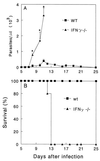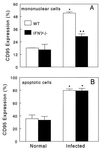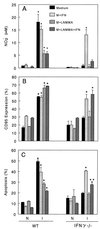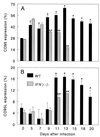Gamma interferon modulates CD95 (Fas) and CD95 ligand (Fas-L) expression and nitric oxide-induced apoptosis during the acute phase of Trypanosoma cruzi infection: a possible role in immune response control
- PMID: 10417150
- PMCID: PMC96666
- DOI: 10.1128/IAI.67.8.3864-3871.1999
Gamma interferon modulates CD95 (Fas) and CD95 ligand (Fas-L) expression and nitric oxide-induced apoptosis during the acute phase of Trypanosoma cruzi infection: a possible role in immune response control
Abstract
We have previously shown that splenocytes from mice acutely infected with Trypanosoma cruzi exhibit high levels of nitric oxide (NO)-mediated apoptosis. In the present study, we used the gamma interferon (IFN-gamma)-knockout (IFN-gamma(-/-)) mice to investigate the role of IFN-gamma in modulating apoptosis induction and host protection during T. cruzi infection in mice. IFN-gamma(-/-) mice were highly susceptible to infection and exhibited significant reduction of NO production and apoptosis levels in splenocytes but normal lymphoproliferative response compared to the infected wild-type (WT) mice. Furthermore, IFN-gamma modulates an enhancement of Fas and Fas-L expression after infection, since the infected IFN-gamma(-/-) mice showed significantly lower levels of Fas and Fas-L expression. The addition of recombinant murine IFN-gamma to spleen cells cultures from infected IFN-gamma(-/-) mice increased apoptosis levels, Fas expression, and NO production. In the presence of IFN-gamma and absence of NO, although Fas expression was maintained, apoptosis levels were significantly reduced but still higher than those found in splenocytes from uninfected mice, suggesting that Fas-Fas-L interaction could also play a role in apoptosis induction in T. cruzi-infected mice. Moreover, in vivo, the treatment of infected WT mice with the inducible nitric oxide synthase inhibitor aminoguanidine also led to decreased NO and apoptosis levels but not Fas expression, suggesting that IFN-gamma modulates apoptosis induction by two independent and distinct mechanisms: induction of NO production and of Fas and Fas-L expression. We suggest that besides being of crucial importance in mediating resistance to experimental T. cruzi infection, IFN-gamma could participate in the immune response control through apoptosis modulation.
Figures







References
-
- Abrahamsohn I A, Coffman R L. Cytokine and nitric oxide regulation of the immunosuppression in Trypanosoma cruzi infection. J Immunol. 1995;155:3955–3963. - PubMed
-
- Adams L B, Hibbs J B, Taintor R R, Kraheenbuhl J L. Microbiostatic effect of murine-activated macrophages for Toxoplasma gondii: role of synthesis of inorganic nitrogen from l-arginine. J Immunol. 1990;144:2725–2729. - PubMed
-
- Albina J E, Cui S, Mateo R B, Reichner J S. Nitric oxide-mediated apoptosis in murine peritoneal macrophages. J Immunol. 1993;150:5080–5085. - PubMed
-
- Boyer M H, Hoff R, Kipnis T L, Murphy E D, Roths J B. Trypanosoma cruzi: susceptibility in mice carrying mutant gene lpr (lymphoproliferation) Parasite Immunol. 1983;5:135–142. - PubMed
Publication types
MeSH terms
Substances
LinkOut - more resources
Full Text Sources
Medical
Research Materials
Miscellaneous

